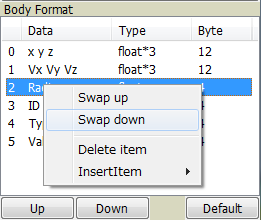Data Loader Dialog provides ways to give information to Zindaiji about the type or format of the data to load.

Select the type of the data, Binary or Text(Ascii).
Select a type of interpolation method.
Gives information about the particle number of the data.
If particle number is constant and particle index is not remmaped over the scene, select constant.
In constant particle number mode, Zindaiji 3 assumes that the n-th particles in any timestep is idendical to the n-th particle in all other timesteps. In this case interpolation calculation is relatively fast.
On the other hand, if particle number increase or decrease, or particle indices are remapped by some reason, there is no guarantee that n-th particle on m-th timestep is identical to the n-th particle on m+1-th timestep.
Thus, Zindaiji uses ID of each particle to search the continuity of particles. Because searching of identical ID is needed, interpolation calculation can be much slower. (Variable mode)
If particles' ID are sorted, searching ID matching can be much faster. When "Sort by ID" is selected, particles are sorted at loading process.
This have some overhead, but ID matching may be much faster for some type of data.
A typical scale or position of the structure depends on the simulation code.
If typical values are too large to small, i.e. 106 or 10-6, or much off-centered, handling them in Zindaiji3 is somewhat cumbersome.
With translate and scaling parameters, you can rescale or offset the whole data when loading.
Scale parameters are applied to position, velocity, and radius.
If you draw too many numbers of too large polygons, the loading to the graphic board can be unexpectedly high.
(For example, drawing 10^7 full screen polygons repeatedly...)
Since Zindaiji3 do not care for the parameters, please be careful not to make such a scene.
Also you can rescale, or take log10 of VALUE1 with "Modify Value1" parameters.
Applying log at data loading stage, we reduce the time for calculate many log10 at every drawing process. (Though, with some incovenience...).
Taking log10 returns 0 if the original VALUE1 is negative.
Rule of filenames for sequential data is as follows.
somename0000.dat
somename0001.dat
somename0002.dat
...
Index must exist just before the extention. Arbitrary charactors for extention are acceptable.
In ASCII format, first two lines must be a header, which tells the time and particle number.
After the header follows the main particle data, one line for one particle. In default state, the order of the data is as shown below.
Thus, the default ascii file format is
TIME
PARTICLENUMBER
X Y Z VX VY VZ RADIUS ID TYPE VALUE1
X Y Z VX VY VZ RADIUS ID TYPE VALUE1
X Y Z VX VY VZ RADIUS ID TYPE VALUE1
and so on...
In binary format, float or integer type binary data must be stacked sequentially,. First 8 byte must be a header, i.e. time (float) and number (int). After the header follows the main particle data.
The default binary file format is
TIME PARTICLENUMBER X Y Z VX VY VZ RADIUS ID TYPE VALUE1 X Y Z VX VY VZ RADIUS ID TYPE VALUE1 X Y Z VX VY VZ RADIUS ID TYPE VALUE1 ... and so on ...
Note that TIME X Y Z VX VY VZ RADIUS VALUE1 are float type (4byte), while PARTICLENUMBER, ID and TYPE are integer type (4byte).
Zindaija can set individual types of visualization parameters.
TYPE represents which parameter each particle uses.
For example, if your data has two types of particles such as stars and gas, assign 0 to TYPE for star and assign 1 for gas, and cofigure each visualization parameters differently.
VALUE1 is data for some sort of physical quantity such as temperature.
Color of particles can depend on VALUE1, as described in Color Curve Dialog.

You can edit the order of variables such as "X Y Z" or "RADIUS" with the Format Editor.
The items are able to move up and down with right-mouse-button menu, or buttons at the bottom side.
With the menu, you can also delete or insert items.
Note that you can insert "dummy items" in the list.
If you have data with variables which is not used for visualization, use dummy items to ignore that variables.
The "Default" button at the right-bottom side makes the list to be the default order.
Note. Currently, Format Editor is not fool-proof. If you load data without necessary items, such as "X Y Z" or "PARTICLENUMBER", the results are unexpectable (segmentation fault, for example...).

Particles in a box of periodic boundary condition can fly from one side to an opposite side in a single time step.
If such particles are interpolated straight forwardly, particles fly across the box with artificial high velocity.
When periodic boundary condition mode is turned on, a particle which moves too large distance in a single time step is interpreted as a particle passing the boundary, and interpolated to the position of mirror particle beyond the boundary.
(or force the velocity component to be 0).
Here, Zindaiji 3 assume that the boundary is box-shaped. Arbitrary shaped boundary is not supported.
Information of box size is required for this functions to work.
Support for shearing periodic boundary conditions is not implemented yet.